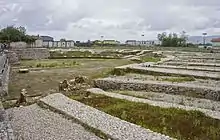Allifae
Allifae was an ancient town of Italy, a center of Oscan or Samnite origin, situated in the valley of the Vulturnus, at the foot of the lofty mountain group now called the Monte Matese, about 40 km northwest of Telesia, and 27 km east-northwest of Teano.
 Amphitheatres of Alife | |
| Location | Alife, Province of Caserta, Italy |
|---|---|
| Region | Campania |
| Type | Settlement |
| Site notes | |
| Management | Soprintendenza per i beni archeologici di Salerno, Avellino e Caserta |
| Public access | Yes |
| Website | Sito Archeologico di Allifae (in Italian) |
It was close to the frontiers of Campania, and is enumerated among the Campanian cities by Pliny,[1] and by Silius Italicus[2] but Strabo expressly calls it a Samnite city[3] That it was so at an earlier period is certain, as we find it repeatedly mentioned in the wars of the Romans with that people. Thus, at the breaking out of the Second Samnite War, in 326 BC, it was one of the first places which fell into the hands of the Romans: who, however, subsequently lost it, and it was retaken by C. Marcius Rutilus in 310 BC. Again, in 307 BC, a decisive victory over the Samnites was gained by the proconsul Fabius beneath its walls.[4] During the Second Punic War its territory was alternately traversed or occupied by the Romans and by Hannibal,[5] but no mention is made of the town itself. Strabo speaks of it as one of the few cities of the Samnites which had survived the calamities of the Social War: and we learn from Cicero that it possessed an extensive and fertile territory in the valley of the Vulturnus, which appears to have adjoined that of Venafrum[6] According to the Liber Coloniarum (p. 231), a colony was established there by the triumvirs, and its colonial rank, though not mentioned by Pliny, is confirmed by the evidence of inscriptions. These also attest that it continued to be a place of importance under the Roman Empire: and was adorned with many new public buildings under the reign of Hadrian.[7]
It is placed by the Itineraries on the direct road from Rome to Beneventum by the Via Latina, at the distance of 17 miles from Teanum, and 43 from Beneventum; but the latter number is certainly too large.[8]
The site of the Samnite city, which in the 4th century BC had a coinage of its own, is not known; the Roman town lay in what are now the comuni of Alife and Sant'Angelo d'Alife, and its walls (4th century) enclose the preserved remains of large baths (Thermae Herculis) and a theatre.[9]
References
- iii. 5. 9.
- viii. 537.
- p. 238.
- Livy viii. 25, ix. 38, 42; Diod. xx. 35.
- Liv. xxii. 13, 17, 18, xxvi. 9.
- Pro Planc. 9, De lege agraria ii. 25.
- August Wilhelm Zumpt, de Coloniis, p. 335; Orell. Inscr. 140, 3887; Romanelli, vol. ii. pp. 451-56.
- Antonine Itinerary pp. 122, 304.
-
 One or more of the preceding sentences incorporates text from a publication now in the public domain: Chisholm, Hugh, ed. (1911). "Allifae". Encyclopædia Britannica. 1 (11th ed.). Cambridge University Press. p. 696.
One or more of the preceding sentences incorporates text from a publication now in the public domain: Chisholm, Hugh, ed. (1911). "Allifae". Encyclopædia Britannica. 1 (11th ed.). Cambridge University Press. p. 696.
 This article incorporates text from a publication now in the public domain: Smith, William, ed. (1854–1857). Dictionary of Greek and Roman Geography. London: John Murray. Missing or empty
This article incorporates text from a publication now in the public domain: Smith, William, ed. (1854–1857). Dictionary of Greek and Roman Geography. London: John Murray. Missing or empty |title=(help)


